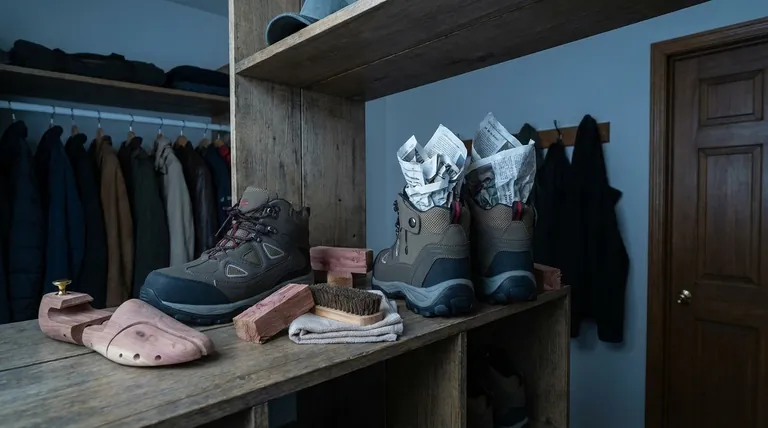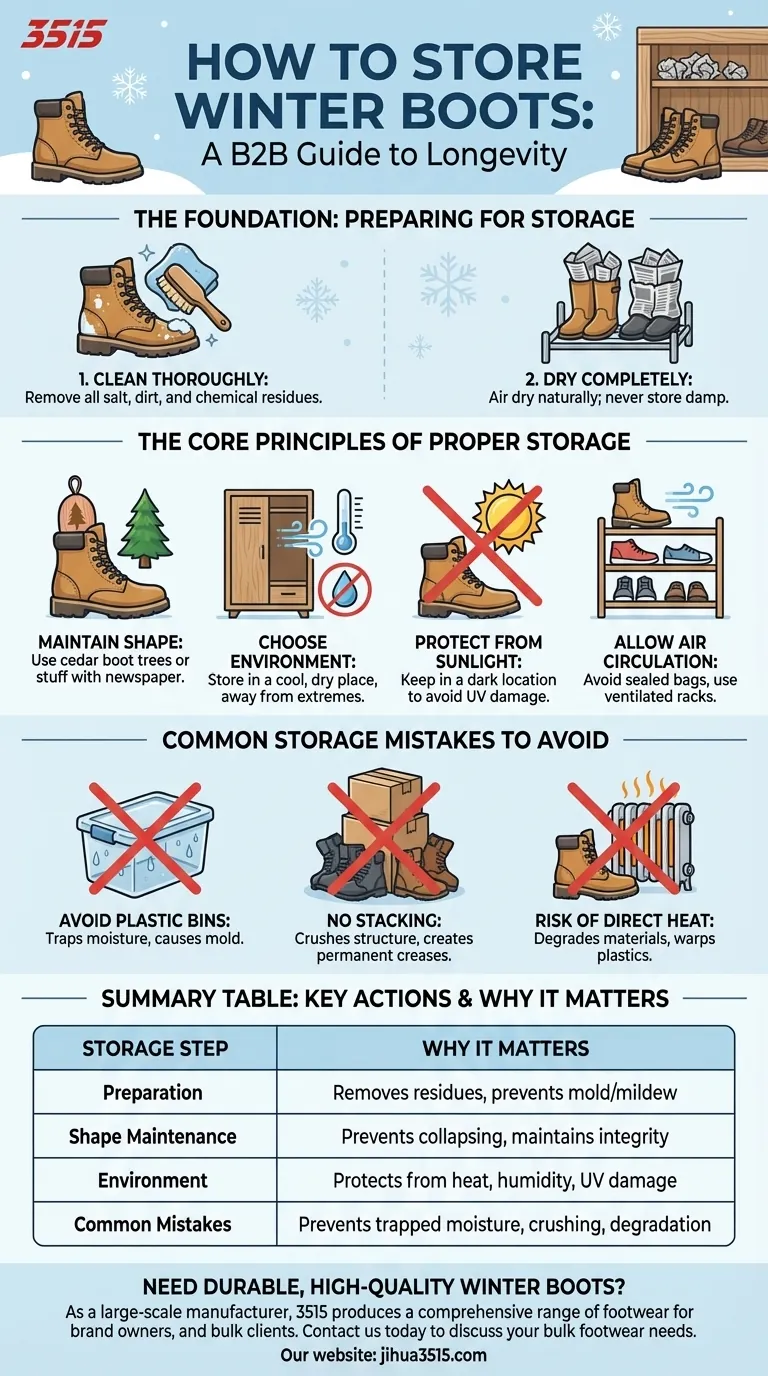To properly store winter boots, ensure they are clean and completely dry, then stuff them to maintain their shape and place them in a cool, dry location with good air circulation, away from direct sunlight or heat.
The goal of winter boot storage is to create a stable environment that protects them from the three primary agents of degradation: moisture, temperature extremes, and physical deformation. Get this right, and you significantly extend the life of your investment.

The Foundation: Preparing Your Boots for Storage
Proper storage begins before the boots even go on the shelf. Skipping these preparatory steps can trap damaging elements inside your boots for months.
Start With a Thorough Cleaning
Before storing, you must remove all salt, dirt, and chemical residues from the boot's surface. These substances can slowly corrode materials, dry out leather, and stain fabric over time.
Ensure They Are Completely Dry
Never store damp boots. Trapped moisture is the primary cause of mold, mildew, and the decomposition of adhesives and other materials.
Always air dry your boots naturally at room temperature. Stuffing them with crumpled newspaper is an effective way to absorb internal moisture and speed up the process without damaging heat.
The Core Principles of Proper Storage
Once your boots are clean and dry, the storage environment itself becomes the critical factor in their preservation.
Maintain Their Structural Shape
Boots can collapse under their own weight over time, leading to permanent creases and a breakdown of ankle support.
Using a boot tree, preferably one made of cedar, is the ideal solution. Cedar helps absorb any residual moisture and odors while perfectly maintaining the boot's form. A less expensive but still effective alternative is to stuff them firmly with newspaper or acid-free paper.
Choose the Right Environment
The consensus is clear: boots must be stored in a cool, dry place. This prevents the materials from becoming brittle from heat or deteriorating from humidity.
A closet in a temperature-controlled part of your home is ideal. Avoid attics, garages, or damp basements where temperature and humidity can fluctuate dramatically.
Protect from Direct Sunlight
Sunlight is another major threat. UV rays can fade colors and cause materials like leather and rubber to dry out, crack, and become brittle. Always store boots in a dark location.
Allow for Air Circulation
Your boots need to breathe. Storing them in sealed plastic bags or airtight containers is a mistake, as it can trap trace amounts of moisture and accelerate material breakdown. A ventilated shoe rack or a simple shelf is far superior.
Common Storage Mistakes to Avoid
Knowing what not to do is as important as knowing what to do. These common errors can ruin a perfectly good pair of boots.
The Problem with Plastic Bins
While convenient for organization, sealed plastic containers prevent air circulation. If there is any latent moisture in the boots, it will be trapped, creating a perfect environment for mold.
The Danger of Stacking or Piling
Never store your boots in a pile or stack heavy objects on top of them. This pressure will crush the boot's structure, create permanent creases, and ruin its supportive shape. Let them stand upright or lie flat with nothing on top.
The Risk of Direct Heat
Storing boots near a heat source like a radiator, furnace, or in a hot attic will rapidly degrade them. Heat can warp plastics, melt glues, and make leather and rubber extremely brittle.
Making the Right Choice for Your Boots
Your approach can be tailored to the value and type of your boots.
- If your primary focus is maximum longevity for expensive boots: Invest in cedar boot trees and store them on an open shelf in a climate-controlled closet after a thorough cleaning and drying.
- If your primary focus is simple, effective storage for everyday boots: Ensure they are clean and bone-dry, stuff them tightly with newspaper, and place them on a rack or in a cardboard box in your closet.
Properly preparing and storing your winter boots ensures they will be ready to perform the moment the first snowflake falls next season.
Summary Table:
| Storage Step | Key Action | Why It Matters |
|---|---|---|
| Preparation | Clean thoroughly and ensure boots are completely dry. | Removes damaging residues and prevents mold/mildew. |
| Shape Maintenance | Stuff with boot trees or newspaper. | Prevents collapsing and maintains structural integrity. |
| Environment | Store in a cool, dry, dark place with good air circulation. | Protects from heat, humidity, and UV damage. |
| Common Mistakes | Avoid plastic bins, stacking, and direct heat sources. | Prevents trapped moisture, crushing, and material degradation. |
Need durable, high-quality winter boots that are built to last? As a large-scale manufacturer, 3515 produces a comprehensive range of footwear for distributors, brand owners, and bulk clients. Our production capabilities encompass all types of shoes and boots, ensuring your customers get reliable performance season after season. Contact us today to discuss your bulk footwear needs and benefit from our expert manufacturing solutions!
Visual Guide

Related Products
- Safety Footwear Wholesale Manufacturer for Custom OEM/ODM Production
- Premium Insulated Safety Boots and Shoes for Wholesale & Bulk Orders
- Durable Rubber Sole Outdoor Shoes Wholesale & Custom Manufacturing
- Wholesale Safety Footwear Manufacturer for Bulk & Custom OEM Orders
- Premium Wholesale Waterproof Safety Boots High Performance Protection for Industrial Markets
People Also Ask
- Do snake bite boots work? Your Ultimate Guide to Effective Snake Bite Protection
- What are OSHA approved shoes? Understanding the Correct Standards for Workplace Safety
- Is safety-toe as good as steel toe? Choose the Right Protection for Your Job
- How long can you wear safety boots? The Lifespan is Determined by Wear, Not Time
- How do safety shoes contribute to cost savings for companies? A Strategic Investment in Risk and Cost Management



















